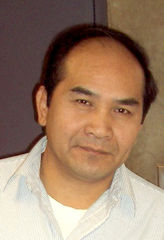RENCONTRER
DIEU |
camboDIATRIBE
|
MEET WITH
GOD |
Military ties warm between US, Vietnam (2006-Feb-08)
By Simon Montlake, Correspondent of The Christian
Science Monitor
HANOI, VIETNAM - As the US casts around for allies in Asia's often turbulent
waters, few countries would appear a more unlikely fit than Vietnam. Diplomatic
ties between the two countries were only restored in 1995. The relationship
is still dogged by the legacy of the "American War," as it's known here.
US teams continue to hunt for the remains of missing servicemen, while
Vietnam struggles to clear the estimated 350,000 tons of unexploded ordnance
dropped by US forces.
But as trade soars between the two former foes - the US is Vietnam's number-one
export market - military ties are also warming up. Vietnam has agreed to
send Army officers on a US training program, and has hosted US warships
at its ports. Last year, after Prime Minister Phan Van Khai made a state
visit to Washington, the two sides agreed to share intelligence on terrorism,
drugs, and other transnational threats. Vietnam is also considering joining
UN peacekeeping operations as a prelude to seeking a non-permanent seat
on the security council. Hanoi last year sent a joint military-civilian
delegation to Haiti to observe the UN mission there, according to a senior
Western diplomat, and has agreed to commit to international peacekeeping
"when circumstances allow."
At the same time, Vietnam isn't taking its eyes
off China, its giant neighbor and historical foe. The two sides
fought a border war in 1979 and only repaired relations in the 1990s after
Vietnam lost its Soviet backers. This need to placate Beijing, and avoid
being part of any nascent US strategy to check Chinese military expansion,
is likely to keep security ties on a slow burner for now, say Western analysts
and diplomats. "For Vietnam to step forward [on security cooperation],
they have to step forward in two directions. They don't want to be roped
into a US containment policy towards China.... They want the US to remain
engaged [in Asia], but they don't want to get too close," says Carl
Thayer, a veteran Vietnam-watcher at the Australian Defense Force Academy.
Vietnam's balancing act is echoed by other Southeast Asian countries that
want to share in the benefits of China's economic rise without losing sight
of the disquiet it provokes among US policymakers who are suspicious of
Beijing's military buildup.
Pentagon sees China as potential rival
On Friday, the Pentagon released a strategic blueprint indicating that
China was a major focus for US military planners. "Of
the major and emerging powers, China has the greatest potential to compete
militarily with the United States," the 92-page Quadrennial
Defense Review stated. Military diplomacy has become a hallmark of the
Bush administration in Asia. Last year, President Bush overruled Congress
to restore full military ties with Indonesia, and has courted India with
civilian-nuclear technology and increased joint military training. US officials
say that forging closer security ties with China's neighbors, including
Vietnam, isn't cold war-style containment. Indeed, some analysts are skeptical
that such a policy could be effective. "This isn't
a zero-sum game. Our activities in Southeast Asia are aimed at improving
relationships with each country, not competing with China,"
says a US military official in the region.
Hoang Anh Tuan, Deputy Director-General at the Institute for International
Relations, a government think-tank, says Vietnam pays close attention to
relations with both China and the US, and is cognizant of the risks of
superpower rivalry in Asia. "What we want to see, and what this region
wants to see, is manageable relations between China and the US. We don't
want to see confrontation," he says.
Trade ties expected to outpace military ties
Despite deep cuts in its ranks, Vietnam still has the largest army in Southeast
Asia (484,000 in 2003). But its aging
weaponry and caps on military spending have blunted its prowess. "It's
a large army but poorly equipped, and large armies don't matter much in
this day and age. It's just a bigger target," says Ian Storey, assistant
professor at the Asia-Pacific Center for Security Studies in Honolulu.
(Vietnamese defense officials declined to be interviewed for this story.)
US officials trying to build bridges with Vietnam say they recognize that
military relations are likely to lag behind economic cooperation, given
the historic baggage. Even the concept of flexible bases now in vogue with
Pentagon planners - access to foreign naval and air facilities - appears
a step too far for Vietnam. Talk of a US Navy return to Cam
Ranh Bay, a naval base that until 2002 was leased to Russia,
has yet to materialize. "We need to understand the history and culture
of Vietnam," says the US military official.
"They approach every issue with very deliberate planning and caution."
A caretaker goes caretaking (2006-Feb-01)
By Chris Costello : Who knows five languages,
travels the world advocating for human rights and can most often be found
as a caretaker in Weldon Library? That would be 17-year Physical Plant
employee Thach Thach
(pronounced "Tatch"). Thach's work with the international organization
Khmers Kampuchea-Krom Federation (KKF) will take him off-campus
and around the world over the next six months in an effort to improve the
lives of Cambodians in South Vietnam. Kampuchea-Krom was the southernmost
territory of the Khmer Empire and means "Cambodia Below". He will participate
in several international conferences involving the International Court,
United Nations' organizations, international governments and the Human
Rights Commission meeting in Geneva. The conference is so in-depth it takes
place over six weeks.
Thach, 50, immigrated to Canada in 1988. He says he can now celebrate his
human rights and Cambodian culture in a way not previously possible while
living in an oppressed area of South Vietnam - home
to more than seven million Khmer Krom,
the indigenous people of Southern Vietnam. |
|
"When I came to Canada, I saw how people were treated different [than
in Cambodia]," explains Thach. "It made me want to do something
for human rights back home". "In South
Vietnam, Cambodians represent the minority population and oppression
by the Vietnamese is prevalent" he
says. Thach and the KKF will visit New York to oversee editing of a UN
documentary film that explores the situation. There will also be visits
to British Columbia, various U.S. states, Australia and Holland. Thach
will return to Geneva in July to participate in a UN
sub-commission on the Promotion and Protection of Human Rights on Indigenous
Populations. Thach has been involved in many
volunteer positions including the RCMP, City Hall, London Police and
the OPP. He says he knew nothing about the groups before volunteering.
"I just went down to see if they needed help," says Thach. "You
can't sit at home complaining you don't know English enough or what to
do - just go."
Thach left Cambodia with a bachelor of literature degree but in Canada
he had to start over. He completed high school, then graduated three years
ago from Western's Administrative and Commercial Studies Program. "You
may start with a job you don't like but you can do more by getting involved
and volunteering," says Thach. "This is my fun." Thach feels
people like him must get involved and make a difference for those who need
help. "If you don't say anything, you get nothing. It's about freedom."
"I want to send a message to people
inside the country [Cambodia]. They have to educate themselves. We hope
people demand the government in a peaceful way, don't use violence... we
seek the international community to put pressure on government to end oppression".
The Khmers Kampuchea-Krom Federation represents over eight million
people worldwide. Thach is president of Khmer Krom Network which is a technology
and Internet working group. For more information visit http://www.khmerkrom.org/
Sihanouk, un neutraliste sanguinaire (2006-Jan-21)
Vithia Kim in Camdisc : We need to educate the world communities
(based on facts) to make them aware of the problems and ask them to help
us. We need to do more research and compile the informations to database/website,
to be used. Here is an excerpt from http://www.globalsecurity.org/military/world/war/cambodia2.htm
:

Tentative de rapprochement
(trop tard) avec les États-Unis
en recevant Jacqueline Kennedy
|
Cambodia
Civil War, 1970s
By the mid-1960s, Sihanouk's delicate
balancing act was beginning to go awry. Regionally, the presence of large-scale
North Vietnamese and Viet Cong logistical bases on Cambodian territory
and the use of Kampong Saom (then Sihanoukville) as a port of disembarkation
for supplies being sent to communist troops, as well as the covert intelligence-gathering,
sabotage missions, and overflights by South Vietnamese and United States
teams had made a sham of Cambodian neutrality.
|

Grand Ami de Zhou Enlai
|
Domestically, Sihanouk's sporadic harassment of the leftists and
the withdrawal of his endorsement from all candidates in the 1966 elections
cost the radicals their chance for victory and alienated them from the
prince as well. Sihanouk also lost the support of the rightists
by his failure to come to grips with the deteriorating economic situation
in the country and with the growing North Vietnamese and Viet Cong military
presence in Cambodia. In addition to these regional developments and the
clash of interests among Phnom Penh's politicized elite, social tensions
also were creating a favorable environment for the growth of a
domestic communist insurgency in the rural areas.
In early 1967, an insurrection broke out in the area around Samlot
in Batdambang, a province long noted for the presence of large landowners
and great disparities of wealth. Local resentment focused on tax
collections and on the decision of the revenuestarved government
to expropriate land to build a sugar refinery near Samlot. In January 1967,
irate villagers attacked a tax collection brigade --an incident that recalled
the 1925 murder of the French resident in the area. With the probable encouragement
of local communist cadres, the insurrection quickly spread through the
whole region. Sihanouk was on one of his frequent sojourns in France, and
Lon Nol, the prime minister, responded harshly. After returning home in
March 1967, Sihanouk personally supervised counterinsurgency measures.
He later mentioned, in an offhand way, that the effectiveness of the royal
armed forces had restored the peace but that approximately
10,000 people had died.
The insurgency was not suppressed completely. It spread rapidly from Batdambang
to the southern and to the southwestern provinces of Pouthisat (Pursat),
Kampong Chhnang, Kampong Cham, Kampong Spoe (Kompong Speu), Kampot, and
the central province of Kampong Thum. By the end of 1968, unrest
was reported in eleven of the country's eighteen provinces. The
Khmer Loeu regions of Mondol Kiri Province and Rotanakiri Province fell
almost entirely under KCP control by the end of the decade.
In January 1968, the communists established the Revolutionary Army of Kampuchea
(RAK). During Sihanouk's last two years in power, the RAK obtained minimal
assistance from the North Vietnamese, the Viet Cong, and the Chinese. Although
North Vietnam had established a special unit in 1966 to train the Cambodian
communists, it was extremely reluctant to alienate Sihanouk at a time when
vital supplies were passing through the port of Kampong Saom and along
the Ho Chi Minh Trail to the Viet Cong bases along the Cambodia-Vietnam
border. Beijing and Moscow also were providing Sihanouk with arms, many
of which were being used against the insurgents. The indifference of the
world communist movement to the Cambodian struggle from 1967 to 1969 made
a permanent impression on Pol Pot and other Khmer Rouge leaders.
The 1970 coup d'état that toppled
Sihanouk dragged Cambodia into the vortex of a wider war. The escalating
conflict pitted government troops, now renamed the Khmer National Armed
Forces (Forces Armées Nationales Khmères-FANK), initially
against the North Vietnamese and the Viet Cong, and subsequently against
the old RAK, now revitalized and renamed the Cambodian People's National
Liberation Armed Forces (CPNLAF).
As combat operations quickly disclosed, the two sides were mismatched.
The inequality lay not so much in sheer numbers. Thousands of young urban
Cambodians flocked to join FANK in the months following the coup and, throughout
its five-year life, the republican government forces held a numerical edge
over their opponents, the padded payrolls and the phantom units reported
in the press notwithstanding. Instead, FANK was outclassed in training
and leadership. With the surge of recruits, the government forces expanded
beyond their capacity to absorb the new inductees. Later, given the press
of tactical operations and the need to replace combat casualties, there
was insufficient time to impart needed skills to individuals or to units,
and lack of training remained the bane of FANK's existence until its collapse.
While individual soldiers and some government units fought bravely, their
leaders -with notable exceptions- were both corrupt and incompetent.
Arrayed against an armed force of such limited capability was arguably
the best light infantry in the world at the time -the North Vietnamese
and the Viet Cong. And when there forces were supplanted, it was by the
tough, rigidly indoctrinated peasant army of the CPNLAF with its core of
Khmer Rouge leaders.
With the fall of Sihanouk, the North Vietnamese and the Viet Cong became
alarmed at the prospect of a pro-Western regime that might allow the United
States to establish a military presence on their western flank. To prevent
this from happening, they began transferring their
military installations away from the border area to locations deeper within
Cambodian territory. A new command center was established at
the city of Kracheh (Kratié). On April 29, 1970, South Vietnamese
and United States units unleashed a multi-pronged offensive into Cambodia
to destroy the Central Office for South Vietnam (COSVN), the headquarters
for North Vietnamese and Viet Cong combat operations in South Vietnam.
Extensive logistical installations and large amounts of supplies were found
and destroyed, but as reporting from the United States MACV subsequently
disclosed, still larger amounts of material already had been moved deeper
into Cambodia.
The North Vietnamese army turned on the republican government forces, and
by June 1970, three months after the coup, they and the CPNLAF had swept
FANK from the entire northeastern third of the country. After defeating
the government forces, they turned newly won territories over to the local
insurgents. The Khmer Rouge also established "liberated areas" in the south
and the southwestern parts of the country, where they operated independently
of the Vietnamese. The KCP's debt to the North Vietnamese after March 1970
was one that Pol Pot was loath to acknowledge; however, it is clear that
without North Vietnamese and Viet Cong assistance, the revolutionary struggle
would have dragged on much longer than it did.
Buddhist Candlelight Vigil for Human Rights and Democracy in Cambodia
(2006-Jan-14)
Lowell Sun : Over 75 Cambodian Americans from the east coast
and Minnesota and their friends and supporters gathered January 13th, 2006
in front of the White House in Washington, D.C. for a Buddhist candlelight
vigil for human rights and democracy in Cambodia. While the main focus
was on the plight of illegally detained human rights and democracy advocate,
Kem Sokha, the ultimate goal was to highlight the absence of freedom and
democracy in Cambodia.
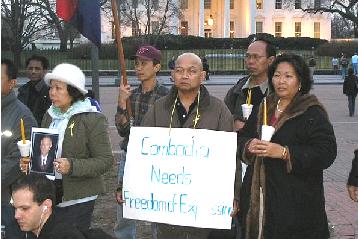 |
|
Featured speakers included Kem Sokha's eldest daughter, Monovithya Kem,
who updated the audience on her father's condition in prison, her younger
sister Samathida and the United Cambodian International
Council (UCIC) co-chairs, Suykry Path from Minnesota and the
Venerable Monk Rithipol of Massachusetts. The UCIC is an umbrella organization
made up of many Cambodian diaspora groups. "We are here to speak on
behalf of the people of Cambodia who are being intimidated by the Cambodian
government to suffer voiceless in their own land," stated Venerable
Monk Rithipol. "Kem Sokha's illegal imprisonment represents what the
Hun Sen government thinks of its people and their inalienable right to
democracy. One year ago President Bush stated that America would stand
with those who stood for democracy. |
President Bush, Kem Sokha and the Cambodian people stand with you for democracy!
Please continue standing with and supporting us!"
urged the Venerable Monk. Suykry Path stated, "It
was an honor to watch President Bush become President at his Inauguration
one year ago. It was moving to hear him stand so strongly for democracy
for all the people of the world. We Cambodians thank President Bush for
this strong support of democracy, and ask that he continue to stand strong
for democracy in Cambodia."
Other featured guests included important representatives from Amnesty
International and the International Republican Institute, two
NGO's who have supported Kem Sokha and his work for human rights and democracy
in Cambodia. They vowed to work to help free Kem Sokha and to help the
people of Cambodia to attain their right to freedom and self-determination
in Cambodian political affairs. The Candlelight vigil included Buddhist
chants recited by Cambodian Monks from three different Temples in attendance.
Below is a link to photographs from the event.
http://share.dell.shutterfly.com/action/welcome?sid=8AYsWLlyzctmPy
www.UCICweb.org , www.freesokha.com
, As reported by Warren Anderson, UCIC advisor.
Cambodia arrests rights activist (2005-Dec-31)
By Guy
De Launey, BBC, Phnom Penh - One of Cambodia's most prominent
human rights activists has been arrested and charged with criminal defamation.
Kem Sokha, as leader of the Cambodian
Center for Human Rights, has been a prominent critic of the government.
A number of opposition figures have been charged with defamation - which
can be a criminal offence under Cambodian law - in recent weeks. Foreign
diplomats have expressed concern that charges are being used to silence
and intimidate the opposition.
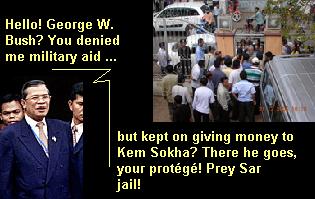
|
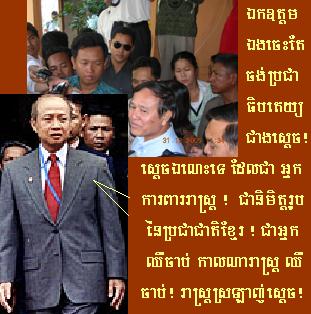
|
The government has defended
its right to prosecute people who it says have broken the law. Police surrounded
the headquarters of the Cambodian Center for Human Rights in the
middle of the morning. They held warrants to search the building and to
arrest the organisation's leader. Foreign diplomats and the United Nations'
Human Rights representative tried to intervene but police barred them from
entering. Eventually, Kem Sokha emerged and police took him to court. Opposition
leader Sam Rainsy was sentenced in absentia last week.
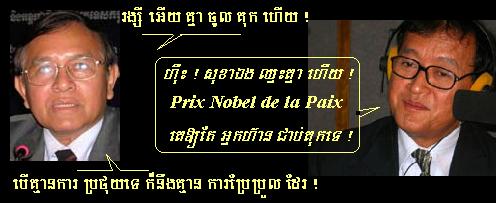
|
The defamation charge stems
from a banner displayed at a rally to mark International Human Rights Day
earlier this month. One of the organisers of the rally [Yen
Vireak, director of the Community Legal Education Centre] also
faces charges. It means that four critics of the government are now in
jail awaiting trial. Five more have left the country rather than face imprisonment.
Last week, the opposition leader, Sam Rainsy, was sentenced in absentia
to 18 months in prison for defaming the leaders of the governing coalition.
|
Touch Sunnix peut s'asseoir et chanter
(2005-Déc-28)

Monsieur Sieng Touch, père de l'ex-chanteuse Touch Sunnix
(dite Srey Nich), a renouvelé ses vifs remerciements à tous
ceux, Cambodgiens ou non, qui ont fait des dons d'argent pour que sa fille
puisse être hospitalisée aux États-Unis. Notons que
le journal Angkor Borei News, dirigé par l'énergique Monsieur
Ly Diep, a lancé un appel de levée de fonds qui a ramassé
18,365.40 $U.S. pour que Touch Sunnix, blessée au cou, et quatre
membres de sa famille puissent venir s'établir en Californie. L'ex-chanteuse
a été victime de tueurs, le 22 octobre 2003 à Phnom
Penh (sa mère, un médecin, qui la protégeait de son
corps était tuée sur le coup). Transportée à
un hôpital de Bangkok en janvier 2004, elle sortait plus tard du
coma, pouvait parler un peu mais souffrait toujours de quadraplégie.
Arrivée depuis un an dans un établissement de San Jose, CA,
son état s'améliore constamment et, d'après le très
sociable et débrouillard président-fondateur de Buddhi Khmer
Center, Monsieur Uch Perom, qui lui a rendu visite en novembre dernier,
Touch Sunnix, 25 ans, peut maintenant se mettre assise et fredonner ses
chansons préférées.
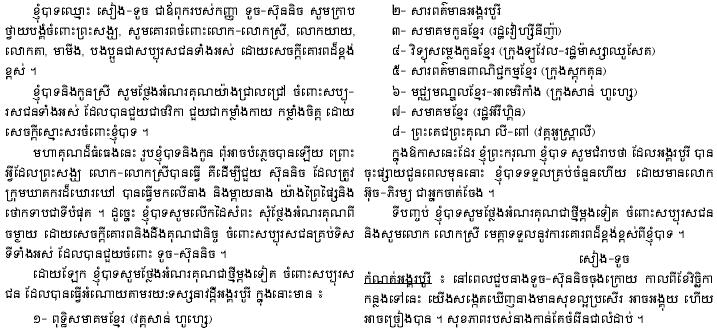
GOD
vs BUDDHA
|
camboDIATRIBE
(
PRÉCÉDENT )
|
COURRI@L
2006
|
AUTRES
SITES KHMERS
|
KUN
PIMOJ 's HOMEPAGE
|
PHN@M-P@NH-P@TINS
|
FRAN-GLO-GIBWÉ
|
CANADA
3 FOUNDERS
|
MES
EMAILS 2003
|
THE
6 COMMANDMENTS
|
MEET
WITH GOD
|
PEN Nearovi, Montréal, Québec, Canada
(nearovi@sympatico.ca)
